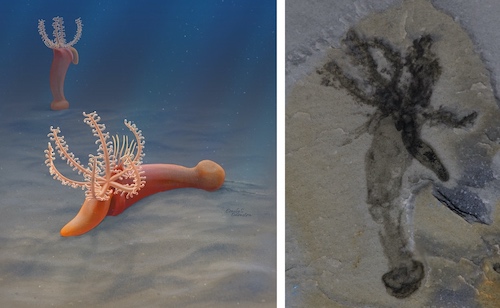Gyaltsenglossus senis, is a newly described hemichordate from the Burgess Shale. It provides evidence on how the anatomies of the two main groups of hemichordates – enteropneusta and pterobranchia – are related.
The enteropneusta and pterobranchia differ in body shape and in ecological function. However, DNA analysis of present day organisms suggests that they are closely related. The two groups look so different that trying to figure out their relationship has been difficult. Gyaltsenglossus, appears to be an intermediary form of the two groups and has traits that are shared by both groups.
Enteropneusta, or acorn worms, live in the sediment (sand, silt, mud) of the seabed and are either deposit feeders or suspension feeders. They have a long proboscis that they use for deposit feeding. By contrast, pterobranchia, are small worm-like filter feeders living in colonies attached to the seabed. They usually secrete a hard tube, for protection, and use their tentacle to feed on plankton in the water.
Gyaltsenglossus, may have used the feeding strategies of both groups of hemichordates. Like the enteropneusta, it had both a long proboscis for deposit feeding; Like the pterobranchia, it had a tentacle for suspension feeding. This suggests that the ancestral form of the hemichordates used both feeding strategies. Over time the two groups, enteropneusta and pterobranchia became more specialized and each retained only one of the two feeding strategies.
Gyaltsenglossus is not the shared ancestor of all hemichordates, but it is likely that hemichordates had their origin in the Cambrian. It is also likely that the original hemichordate looked quite similar to Gyaltsenglossus.
33 Gyaltsenglossus fossils were found in the 506 million year old Burgess Shale deposit on Odaray Mountain, BC, in Yoho National Park, in the Canadian Rocky Mountains. The research was undertaken by a collaboration of the Royal Ontario Museum, The Smithsonian National Museum of Natural History, and the University of Montreal.
For more information please read the ROM’s press release. Alternatively, please read the academic paper published in Current Biology.
Nanglu et al. Cambrian Tentaculate Worms and the Origin of the Hemichordate Body Plan. Current Biology, published online August 27, 2020; DOI: https://doi.org/10.1016/j.cub.2020.07.078.

